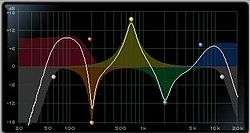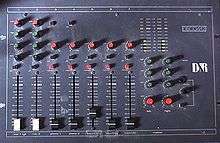Audio filter

An audio filter is a frequency dependent amplifier circuit, working in the audio frequency range, 0 Hz to beyond 20 kHz. Audio filters can amplify ("boost"), pass or attenuate ("cut") some frequency ranges. Many types of filters exist for different audio applications including hi-fi stereo systems, musical synthesizers, sound effects, sound reinforcement systems, instrument amplifiers and virtual reality systems.
Types
Low-pass
Common types include low-pass filters, which pass through frequencies below their cutoff frequencies, and progressively attenuates frequencies above the cutoff frequency. Low-pass filters are used in audio crossovers to remove high-frequency content from signals being sent to a low-frequency subwoofer system.
High-pass
A high-pass filter does the opposite, passing high frequencies above the cutoff frequency, and progressively attenuating frequencies below the cutoff frequency. A high-pass filter can be used in an audio crossover to remove low-frequency content from a signal being sent to a tweeter.
Bandpass
A bandpass filter passes frequencies between its two cutoff frequencies, while attenuating those outside the range. A band-reject filter, attenuates frequencies between its two cutoff frequencies, while passing those outside the 'reject' range.
All-pass
An all-pass filter passes all frequencies, but affects the phase of any given sinusoidal component, according to its frequency.
Applications
In some applications, such as in the design of graphic equalizers or CD players, the filters are designed according to a set of objective criteria such as pass band, pass band attenuation, stop band, and stop band attenuation, where the pass bands are the frequency ranges for which audio is attenuated less than a specified maximum, and the stop bands are the frequency ranges for which the audio must be attenuated by a specified minimum. In more complex cases, an audio filter can provide a feedback loop, which introduces resonance (ringing) alongside attenuation. Audio filters can also be designed to provide gain (boost) as well as attenuation. In other applications, such as with synthesizers or sound effects, the aesthetic of the filter must be evaluated subjectively.
Audio filters can be implemented in analog circuitry as analog filters or in DSP code or computer software as digital filters. Generically, the term 'audio filter' can be applied to mean anything which changes the timbre, or harmonic content of an audio signal.
Self-oscillation
Self-oscillation occurs when the resonance or Q factor of the cutoff frequency of the filter is set high enough that the internal feedback causes the filter circuitry to become a sine tone sine wave oscillator.
See also
- Electrical resonance
- Electronic filter
- Equalization (audio)
- Feedback
- Linear filter
- Oscillation
- Self-resonant frequency
